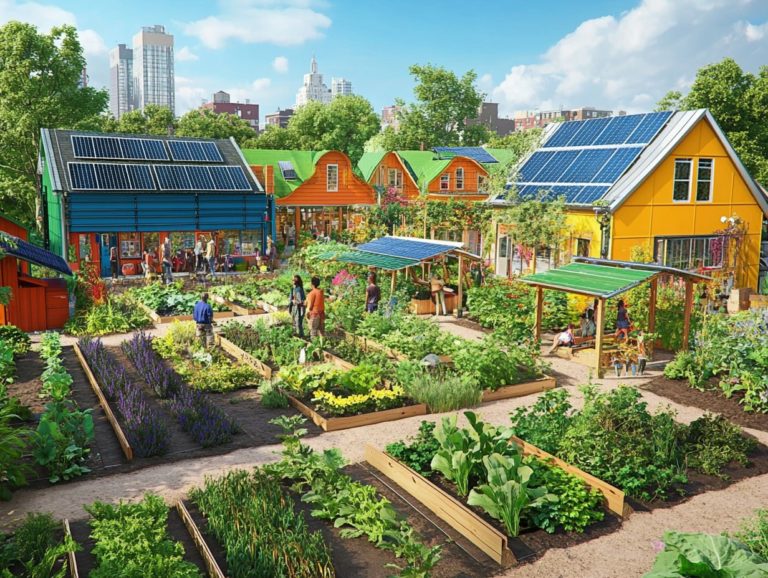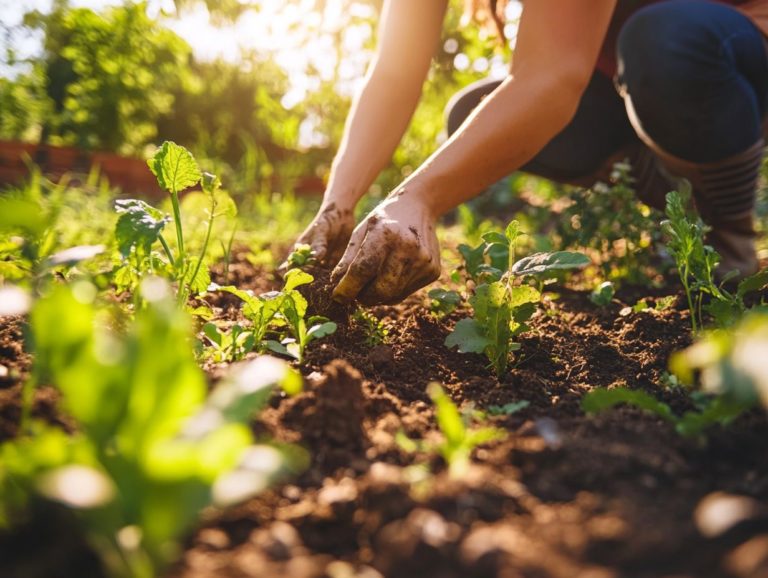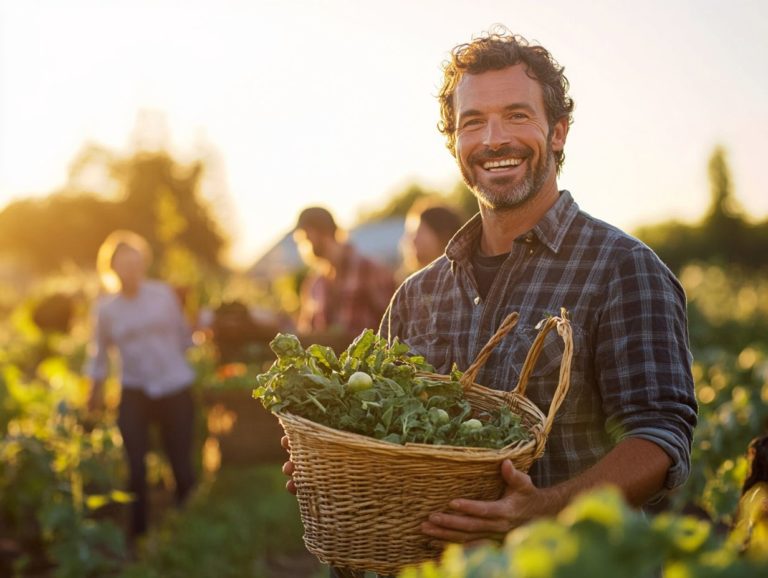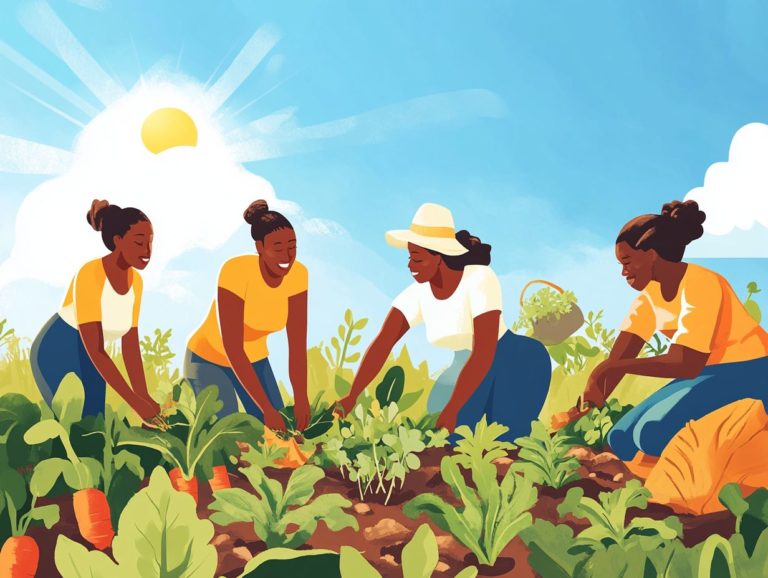53. How to Leverage Local Resources for Permaculture
Permaculture presents a holistic approach to sustainable living. It allows you to harmonize with nature while making the most of local resources and embracing permaculture ethics.
This exploration delves into the core principles of permaculture. We will begin with how to identify and utilize what s available in your environment, including indigenous tree crops.
From assessing native plants and materials to mastering effective composting techniques and water conservation methods, such as keyline design, you ll uncover practical strategies to enhance your garden or community.
Discover how collaborating with local communities can have a profound impact. Working together brings environmental and social benefits from leveraging local resources. Join us on this exciting journey toward sustainable living and unlock your potential for positive change!
Contents
- Key Takeaways:
- Understanding Permaculture Principles
- Identifying and Utilizing Local Resources
- Permaculture Techniques for Sustainable Living
- Collaborating with Local Communities
- Benefits of Leveraging Local Resources for Permaculture
- Frequently Asked Questions
- 1. Why should I care about permaculture?
- 2. How can I leverage local resources for permaculture?
- 3. What are some examples of local resources that can be used in permaculture?
- 4. How does leveraging local resources benefit permaculture practices?
- 5. Are there any challenges to leveraging local resources for permaculture?
- 6. How can I learn more about leveraging local resources for permaculture?
Key Takeaways:
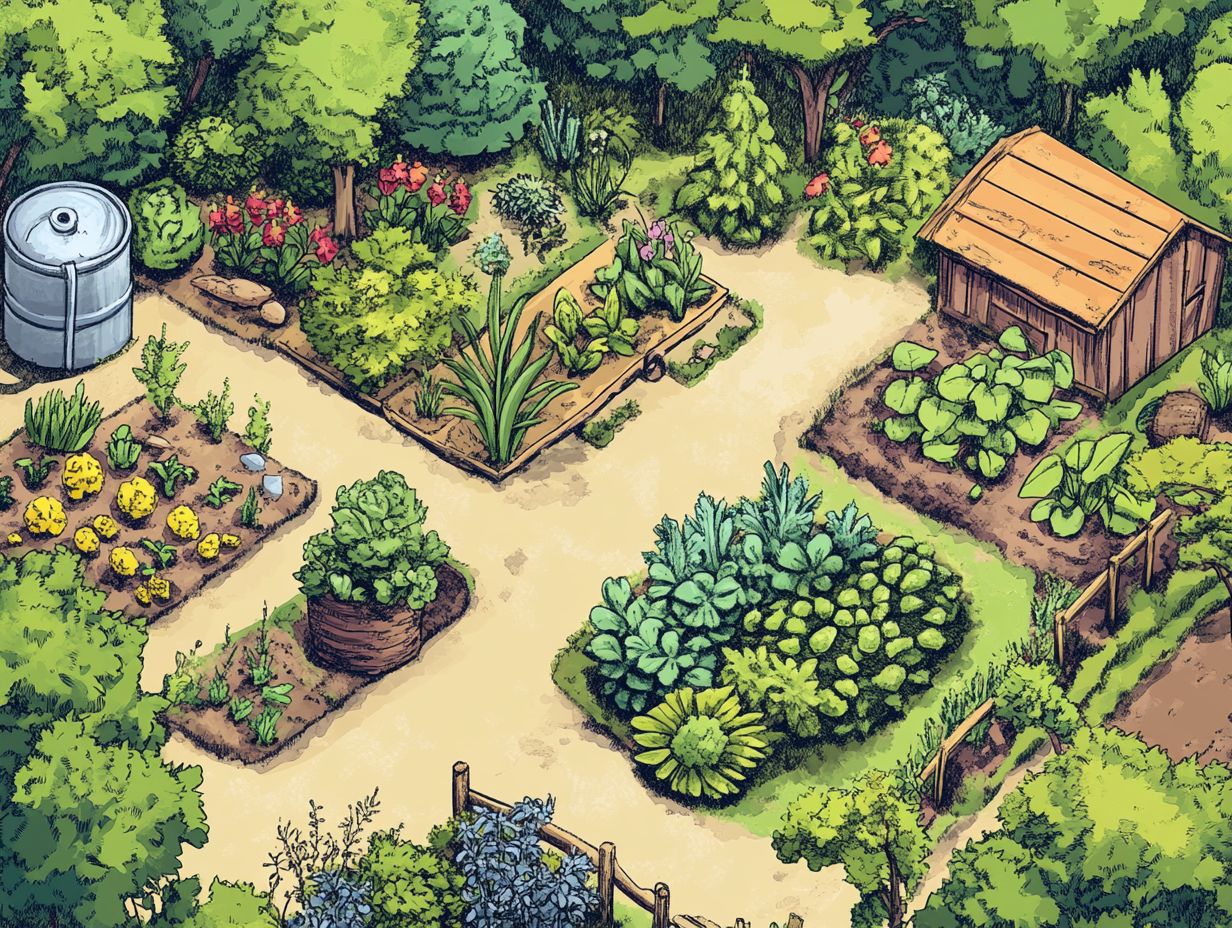
- Use indigenous plants and tree crops to build a sustainable permaculture system.
- Implement composting and no-dig gardening to reduce environmental impact.
- Work with local communities to share knowledge and make a positive impact.
Understanding Permaculture Principles
Grasping the fundamental principles of Permaculture is crucial for cultivating sustainable agriculture and nurturing resilient communities. This concept was developed by Bill Mollison and David Holmgren.
Permaculture focuses on the seamless integration of ecological systems with human design principles. This creates a self-sustaining environment that fosters biodiversity, improves soil health, and optimally utilizes local resources.
By embracing these principles, you can engage in regenerative agriculture practices, such as crop rotation. These practices ensure the longevity of both the environment and the community, setting the stage for a sustainable future.
Identifying and Utilizing Local Resources
Identifying and utilizing local resources is a cornerstone of sustainable agriculture. For those interested in deepening their knowledge, learning how to create a permaculture resource library significantly enhances community resilience and promotes permaculture ethics.
By recognizing the potential of indigenous plants, including tree crops and materials, you can enrich biodiversity. This will help cultivate a more self-sustaining ecosystem that thrives on local dynamics.
Engaging the community in this journey strengthens connections. It also fosters a deeper understanding of the ecological systems surrounding us, enhancing community resilience.
Assessing Available Resources
Assessing your available resources is a crucial step in utilizing local assets for sustainable agriculture. This process is informed by keyline design and building community resilience through permaculture.
By systematically evaluating key components like soil health, water availability, and biodiversity, you gain a clearer understanding of your environment s needs and strengths.
For example, conducting soil assessments through techniques such as sampling and analysis can reveal insights into nutrient levels and microbial activity. Permaculture techniques can further enhance soil fertility.
Similarly, evaluating your water resources with hydrological studies enables you to determine sustainable irrigation practices, such as rainwater harvesting. This also helps safeguard vital ecosystems.
Biodiversity assessments, including species inventories and habitat evaluations, will guide your conservation efforts and land use planning.
This holistic approach to sustainable land management, including permaculture design principles, supports agricultural productivity while maintaining ecological integrity.
Maximizing Use of Indigenous Plants and Materials
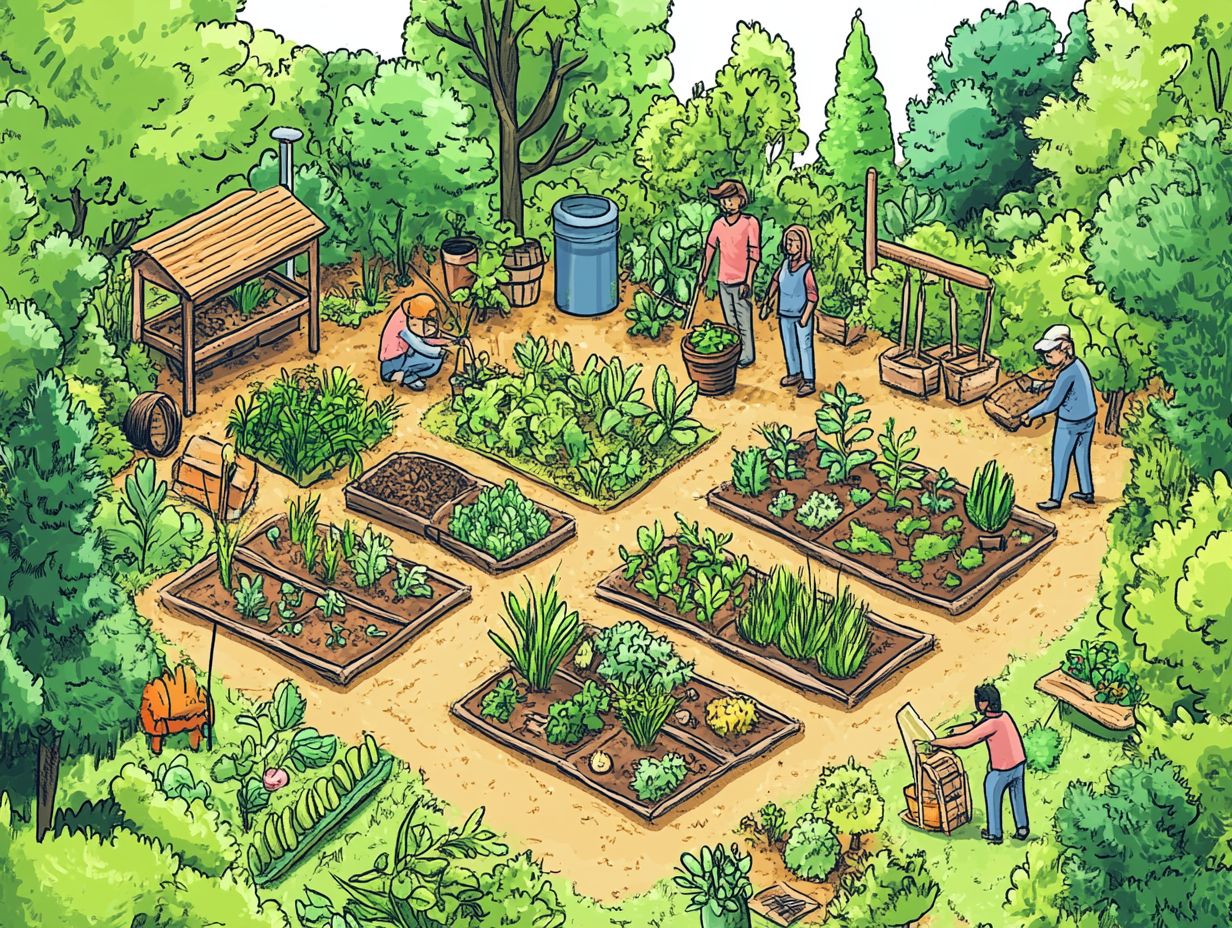
Maximizing the use of indigenous plants and materials is essential for biodiversity. It enhances sustainable farming, particularly through no-dig gardening, which means growing plants without disturbing the soil.
Native species create resilient ecosystems. They are adapted to local climates and soils, supporting wildlife and enhancing habitats.
A recent permaculture project in the Pacific Northwest integrated local berry bushes and guilds. This not only provided nourishment for humans and pollinators but also improved soil health.
A case study from Australia showed how incorporating drought-resistant indigenous grasses into a permaculture design boosted water retention and reduced erosion. This demonstrates the benefits of using local plants.
Focus on local plants! They can help create a thriving agricultural system that works with nature.
Permaculture Techniques for Sustainable Living
Permaculture offers various techniques for sustainable living. Methods like no-dig gardening, crop rotation, and water harvesting are designed to foster regenerative agriculture.
These strategies enhance soil health and ensure the efficient use of local resources. They minimize environmental impact through permaculture principles, and learning how to engage with local permaculture initiatives can further support these efforts.
By embracing these techniques, you can cultivate self-sustaining systems. These systems meet your needs while harmonizing with the broader ecosystem.
This contributes to community resilience and sustainability.
Composting and Soil Management
Composting and effective soil management are vital for enhancing soil health. These practices include using organic matter to promote regenerative agriculture.
Composting recycles organic matter and fosters a thriving environment for beneficial microorganisms. This ensures soil health and resilience.
Techniques like layering green and brown materials and maintaining optimal moisture levels expedite decomposition. This enhances soil fertility.
Composting also reduces landfill waste, making it integral to sustainable living. Using compost as a top dressing for fruit trees and integrating it into vegetable beds enriches nutrient availability.
This strategy ensures that soil remains fertile and resilient, supporting diverse ecosystems.
Water Harvesting and Conservation
Water harvesting and conservation are essential for sustainable agriculture, especially in regions facing water scarcity. These methods secure water availability for crops while bolstering soil health.
Rainwater harvesting allows communities to capture and use precipitation effectively. This turns a natural resource into a vital asset for farming and household needs.
Keyline design optimizes water distribution across landscapes. It enhances irrigation practices while respecting natural water flows, supporting sustainable agriculture.
By integrating these practices, you can cultivate resilient ecological systems. They adapt to climate changes and nurture a culture of sustainability for future generations.
Collaborating with Local Communities
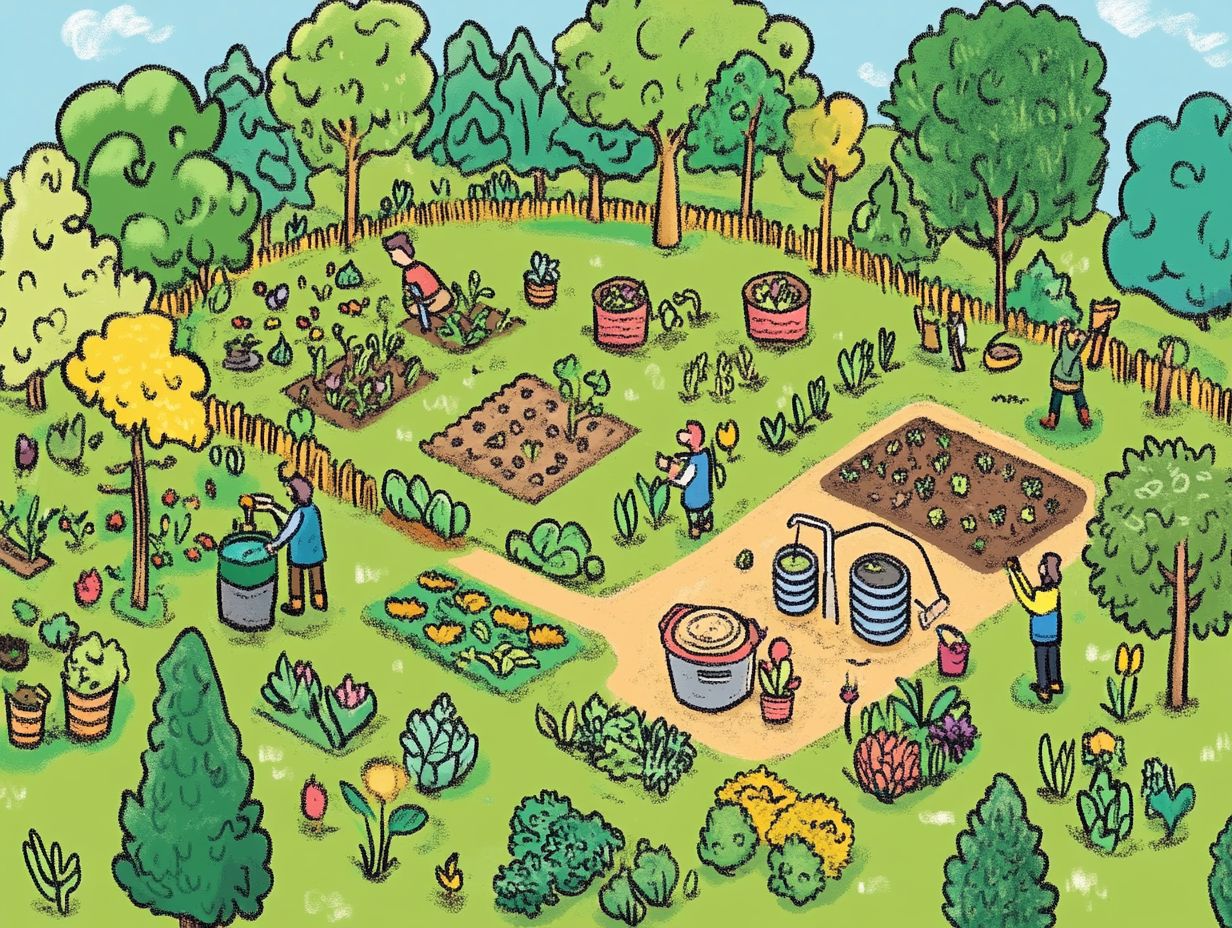
Collaborating with local communities is essential for enhancing strength and promoting sustainable agriculture practices. This fosters a sense of community ownership. By building strong relationships and sharing valuable knowledge, you can effectively leverage the unique resources available in your area, such as indigenous plants, and utilize essential tools for community permaculture projects to create mutually beneficial systems.
This collaborative approach strengthens social ties and cultivates a profound sense of ownership and responsibility toward ecological systems and sustainable practices.
Building Relationships and Sharing Knowledge
Building relationships and sharing knowledge within communities enhances resilience and fosters sustainable practices aligned with the principles of permaculture.
Engaging in community workshops, events, and educational programs allows you to connect with others, creating a sense of belonging and a shared purpose rooted in sustainable agriculture. These initiatives provide a platform for exchanging valuable insights and enable you to make the most of local resources, ultimately contributing to a more sustainable environment and community strength.
Knowledge sharing is vital for tackling community challenges. It allows individuals to collaborate on solutions tailored to their unique circumstances, reflecting permaculture ethics. As these networks expand and strengthen, the principles of mutual support and innovation take hold, fostering community vitality and resilience.
Benefits of Leveraging Local Resources for Permaculture
Leveraging local resources for permaculture offers a wealth of benefits, from bolstering community strength to enhancing biodiversity and fostering sustainable agriculture practices. For more insights, check out how to use permaculture principles in community design, which aligns with the ethical principles of permaculture.
By tapping into what your local environment has to offer, you can cultivate robust ecosystems that support agricultural endeavors. This also strengthens social connections and a shared sense of responsibility for the land, embodying permaculture ethics. For more insights on fostering these connections, check out how to develop community leadership in permaculture.
This approach beautifully aligns with the ethical principles of permaculture, encouraging harmonious coexistence between humans and nature.
Environmental and Social Impact
The environmental and social impacts of harnessing local resources for permaculture are profound, playing a significant role in sustainable agriculture worldwide.
By embracing permaculture practices, you nurture your ecosystem, leading to enhanced biodiversity and healthier soil. This holistic approach allows local flora and fauna to flourish and fosters a deeper connection between you and your environment. As you engage in sustainable farming techniques, stronger community ties naturally develop.
Knowledge sharing becomes second nature as farmers exchange best practices, traditional wisdom, and innovative ideas. This collaborative spirit has the potential to uplift vulnerable groups, empower women, and promote a sense of unity. In doing so, it ensures not just food security but also a resilient social fabric that stands strong against environmental challenges.
Frequently Asked Questions
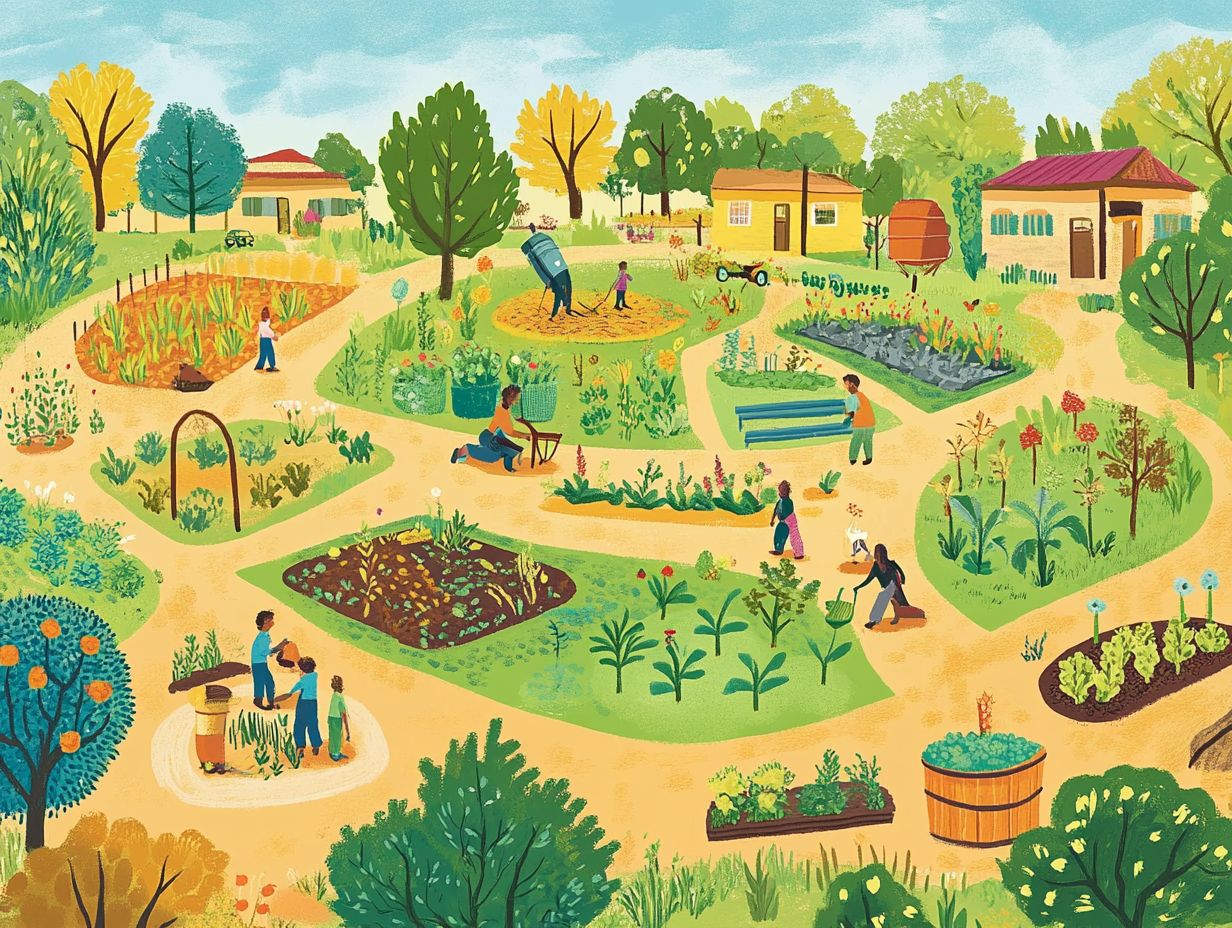
1. Why should I care about permaculture?
Permaculture is a holistic approach to gardening and agriculture that aims to create self-sustaining ecosystems. Its importance lies in promoting environmental sustainability, food security, and community strength.
2. How can I leverage local resources for permaculture?
You can leverage local resources for permaculture by using materials and resources readily available in your local environment. These can include plants, soil, water, and natural materials for building and mulching.
Unlock the power of local resources today! Join your local community and start your sustainable journey now!
3. What are some examples of local resources that can be used in permaculture?
Local resources for permaculture include compost from food waste and rainwater collected in barrels. You can also use fallen branches or rocks to build raised garden beds. For more ideas, check out local resources for sustainable living, and remember that native plants that thrive in your local climate are excellent choices too.
4. How does leveraging local resources benefit permaculture practices?
Using local resources helps reduce the need for importing materials, which can harm the environment. It creates a self-sufficient and sustainable system that benefits everyone.
5. Are there any challenges to leveraging local resources for permaculture?
Challenges can include a limited supply of certain resources and a lack of knowledge about local plants and materials. Researching and consulting local experts before starting is crucial to navigate these challenges.
6. How can I learn more about leveraging local resources for permaculture?
You can find valuable information through books, online courses, and workshops. Joining local permaculture groups is also helpful, and utilizing local resources for organic gardening can enhance your learning. Observing successful permaculture gardens nearby can provide real-world insights.



